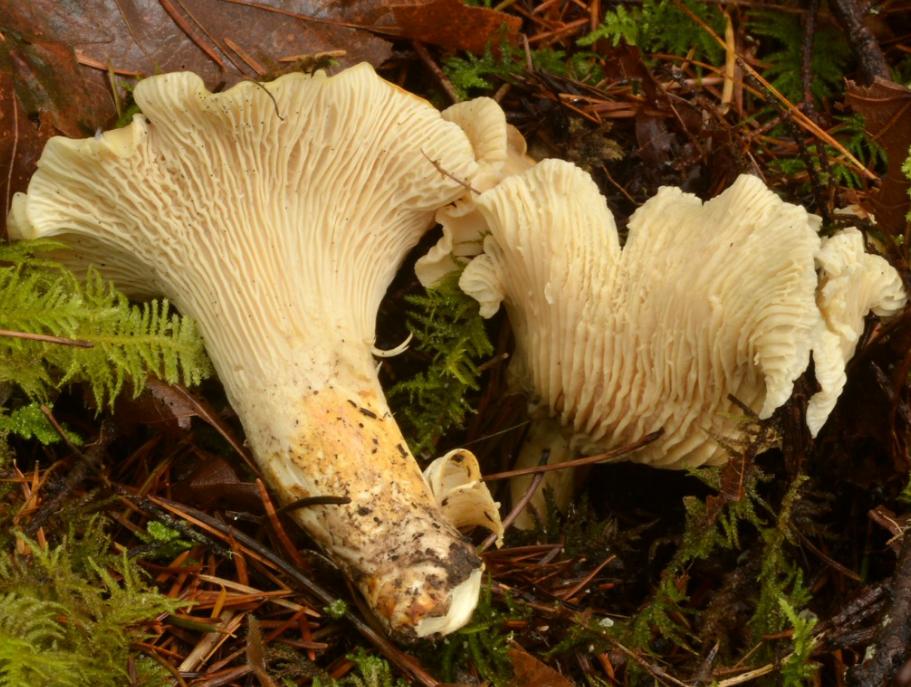The white chanterelle[i] is a choice edible mostly found in the Pacific Northwest of the United States. It differs from other chanterelles in its whitish color and in its scent—unlike most, it does not smell like apricot. All parts of the mushroom are whitish but can discolor to yellowish or orangish. The White Chanterelle goes by it’s scientific name Cantharellus subalbidus.
While the white chanterelle is not generally considered medicinal, it is a healthy food. Some claims for medicinal value have been made for related species[ii].

My name is Austin Collins.
I've dedicated my life to Mushrooms.
I believe Mushrooms are the best kept secret when it comes to health and well being.
For that reason, I would like to share a company with you that in my opinion makes the best mushroom products on the market.
The company is called Noomadic Herbals, my favorite supplement they make is called "Mushroom Total".
I take their products every day and they have helped me think better and have more energy. Give them a try.
-Austin
Cantharellus subalbidus Identification and Description
Cap: The cap is not distinct from the stem, which simply flares open at the top like a trumpet. May become irregular in shape with age. Sometimes large. White or whitish, bruising yellowish to orangish.
Gills: There are no gills. Instead, there are low ridges, often called false gills, that run partway down the stem.
Stem: Not structurally distinct from the cap—widens gradually from the base. Relatively short, solid, white. Bruises yellowish or orangish.
Smell: Fragrant, but not fruity.
Taste: Not distinct for identification. Not peppery.
Spores: Ellipsoid, smooth.
Spore color: White.
Edibility: Considered choice.
Habitat: Mycorrhizal on Douglas-fir and other conifers. Fruits alone or in scattered groups.
White chanterelles[iii] almost never fruit outside of old-growth forests. Whether that’s because the species can’t grow in younger forests or because it can grow in younger forests but can’t fruit there is not clear, but if a mushroom is not in old growth, it’s probably not a white chanterelle.
Chanterelles of all types are often mistaken for non-chanterelle species; the key is to remember that chanterelles don’t have gills or a distinct cap. Rather, a stem-like structure flares outward like a trumpet. Low, branching ridges on the outer surface of the trumpet’s bell release the spores. If a mushroom has gills (even short gills) and a distinction between cap and stem, it is not a chanterelle.
Cantharellus subalbidus Benefits
The primary use of Cantharellus subalbidus is culinary, and they make a healthy—and reputedly delicious—food. Like most other mushrooms, they have a lot of water weight, meaning that they wouldn’t make a very good staple food; it would be difficult to eat enough of the stuff to come close to meeting daily nutrition needs. But by the same token, the mushrooms can add a lot of flavor to a meal without adding a lot of calories. A typical serving provides a little protein and fiber, but no fat[iv]. As to vitamins and minerals, they may be present, but not in nutritionally meaningful amounts.
White chanterelle has not been investigated for medicinal benefits, but a related species, the golden chanterelle (C. cibarius) has been. The golden chanterelle is an antioxidant and an antibiotic, and an extract of the species has been shown able to speed wound healing in animal experiments[v]. It is at least possible that white chanterelle has similar potential.
Cantharellus subalbidus Dosage
White chanterelles are not currently used as medicine, so dosage is not an issue.
Cantharellus subalbidus Toxicity & Side Effects
White chanterelles are not toxic, nor are any other chanterelles known to be toxic—though, like any other food, it is possible some individuals could have an allergic reaction or other issue. But foragers should be cautious, since some vaguely similar mushrooms are at least mildly toxic.
References:
[i] California Fungi—Cantharellus subalbus. MykoWeb website.
[ii] Simoloka, A. (2014). Medicinal Powers of Chanterelle Mushrooms. Zambian Eye.
[iii] Kuo, M. (2015). Cantharellus aubalbus.
[iv] Chanterelle Mushrooms. Eat This Much website.
[v] Nasiry, D., Khalatbary, A.R., Ebrahimzadeh, M.A. (2017). Anti-inflammatory and Wound-healing Potential of Golden Chanterellel Mushroom, Cantharellus cibarius (Agaricomycetes). International Journal of Medical Mushrooms 19(10): 893-903.



I’ve often seen white chanterelle in second growth Douglas-fir forest in coastal British Columbia.
well your pic here vs from guide books we use convinces that we found near a huge white pine in central ontario a singleton white chanterelle! the comment re old growth seems germane, the area was logged over around 150 yr ago, has by now many lg esp white pine regrowth, but this huge girth one must have been overlooked in the stripping operation back when, possibly allowing for refruiting
being a singleton i guess we’ll dry to keep for show, or maybe try to “seed” some other areas we know of with huge white pines…
I have found them on the road side on a raised moss covered bank under old Beech trees in The Scottish Borders, growing in a dense cluster interspersed with the more conventional orange cantharellus.
While the orange species were quite big already (between 1 and 2″ diameter) and had broken fringes, the white ones are growing slower, or are coming out a bit later or are simply a smaller species, time will tell
You will find white chants where hemlock and vine maple meet